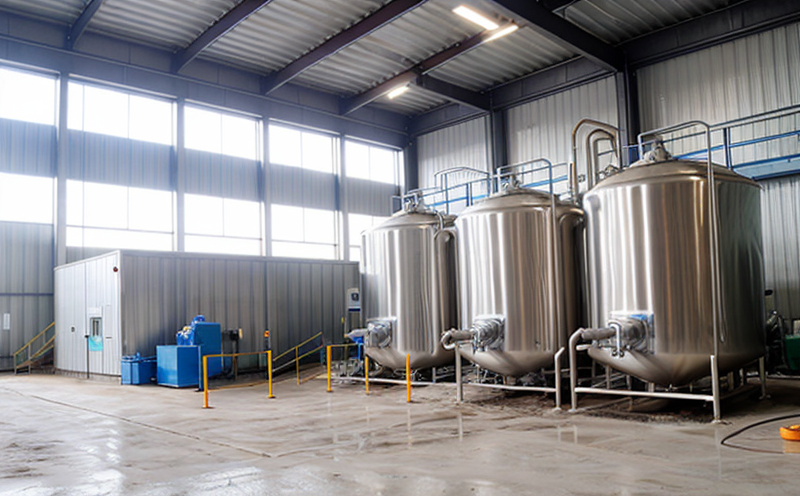ASTM D5907 Nutrient Nitrogen and Phosphorus Test in Industrial Water
In industrial settings where water quality is critical to process efficiency and environmental compliance, accurate testing of nutrient nitrogen (specifically ammonia, nitrite, and nitrate) and phosphorus levels is essential. The ASTM D5907 standard provides a robust methodology for the determination of these parameters in industrial process water.
This test is particularly important for industries such as food processing, pharmaceuticals, and chemical manufacturing. These sectors rely on high-quality water to ensure product safety and environmental sustainability. Compliance with international standards like ASTM D5907 helps companies avoid regulatory penalties and maintain a good reputation among customers who expect environmentally responsible practices.
The test outlined in ASTM D5907 is designed to detect the presence of nutrients that can lead to water quality issues. Excess nitrogen, especially ammonia, nitrite, and nitrate, as well as phosphorus, can cause eutrophication, which depletes oxygen levels in water bodies, harming aquatic life. By adhering to this standard, industrial facilities can mitigate these risks by monitoring their water systems.
Compliance officers responsible for environmental protocols will find ASTM D5907 invaluable when setting internal standards and reporting to regulatory authorities. Quality managers need accurate nutrient data to ensure that process water meets the required quality benchmarks, while R&D engineers use this information to optimize treatment processes and reduce waste generation. For procurement teams, knowing these parameters helps in selecting suppliers who adhere to stringent water quality criteria.
The ASTM D5907 method involves several steps: sample collection, preservation, analysis of ammonia, nitrite, nitrate, and phosphorus content using colorimetric methods or spectrophotometry. The test results provide a clear picture of the nutrient levels in industrial process water, enabling informed decisions on treatment strategies.
The standard's focus on accuracy and precision ensures that the data generated can be trusted for regulatory compliance and internal quality assurance purposes. By adhering to ASTM D5907, industrial facilities demonstrate their commitment to sustainable operations and environmental stewardship.
Applied Standards
| Standard Number | Description |
|---|---|
| ASTM D5907-18 | American Society for Testing and Materials Standard Method for Determination of Nitrogen Compounds in Water by Flow Injection Analysis |
| ISO 6223:2007 | International Organization for Standardization Standard for Nitrate in Drinking Water |
| EN 14812-2005 | European Norm for Determination of Ammonia in Wastewater by Flow Injection Analysis |
| IEC 62379:2011 | International Electrotechnical Commission Standard for Water Quality - Nutrients - Determination of Nitrogen and Phosphorus |
Scope and Methodology
The ASTM D5907 method involves the following steps:
- Sample Collection: Samples are collected from various points within the industrial facility, including feedwater, treated water, and effluent. Proper aseptic techniques ensure that samples remain uncontaminated.
- Preservation: Depending on the nutrient being measured, appropriate preservatives may be added to stabilize the sample for transport to the laboratory.
- Analysis: The most common methods used are flow injection analysis (FIA) and spectrophotometry. These techniques measure the absorbance of light by the colored compounds formed during the reaction with reagents specific to nitrogen and phosphorus.
The standard specifies detailed procedures for each step, including calibration, blank preparation, and quality control checks. The precision and accuracy of the results are ensured through rigorous validation protocols that compare test results against certified reference materials.
Compliance officers should be aware that deviations from these steps can lead to inaccurate readings, which may result in non-compliance with environmental regulations. Therefore, adherence to ASTM D5907 is crucial for reliable and consistent data generation.
Benefits
- Environmental Compliance: Ensures adherence to local, national, and international regulations regarding nutrient levels in industrial water.
- Risk Management: Identifies potential risks of water quality issues that could impact operations or the environment.
- Quality Assurance: Provides data for continuous improvement of water treatment processes within industrial facilities.
- Customer Satisfaction: Demonstrates a commitment to producing high-quality products by using clean, treated process water.
The benefits of adhering to ASTM D5907 extend beyond compliance; they also enhance the reputation of the facility and contribute positively to public health and environmental sustainability.





